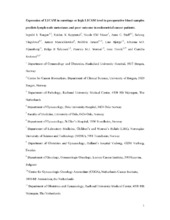Expression of L1CAM in curettage or high L1CAM level in preoperative blood samples predicts lymph node metastases and poor outcome in endometrial cancer patients
Tangen, Ingvild Løberg; Kopperud, Reidun Kristin; Visser, Nicole C.M.; Staff, Anne Cathrine; Tingulstad, Solveig; Marcickiewicz, Janusz; Amant, Frédéric; Bjørge, Line; Pijnenborg, Johanna M.A.; Salvesen, Helga; Werner, Henrica Maria Johanna; Trovik, Jone; Krakstad, Camilla
Peer reviewed, Journal article
Accepted version
Permanent lenke
https://hdl.handle.net/1956/17586Utgivelsesdato
2017-09Metadata
Vis full innførselSamlinger
Originalversjon
https://doi.org/10.1038/bjc.2017.235Sammendrag
Background: Several studies have identified L1 cell adhesion molecule (L1CAM) as a strong prognostic marker in endometrial cancer. To further underline the clinical usefulness of this biomarker, we investigated L1CAM as a predictive marker for lymph node metastases and its prognostic impact in curettage specimens and preoperative plasma samples. In addition, we aimed to validate the prognostic value of L1CAM in hysterectomy specimen. Methods: Immunohistochemical staining of L1CAM was performed for 795 hysterectomy and 1134 curettage specimen from endometrial cancer patients. The L1CAM level in preoperative blood samples from 372 patients was determined using ELISA. Results: Expression of L1CAM in curettage specimen was significantly correlated to L1CAM level in corresponding hysterectomy specimen (P<0.001). Both in curettage and preoperative plasma samples L1CAM upregulation was significantly associated with features of aggressive disease and poor outcome (P<0.001). The L1CAM was an independent predictor of lymph node metastases, after correction for curettage histology, both in curettage specimen (P=0.002) and plasma samples (P=0.048). In the hysterectomy samples L1CAM was significantly associated with poor outcome (P<0.001). Conclusions: We demonstrate that preoperative evaluation of L1CAM levels, both in curettage or plasma samples, predicts lymph node metastases and adds valuable information on patient prognosis.
